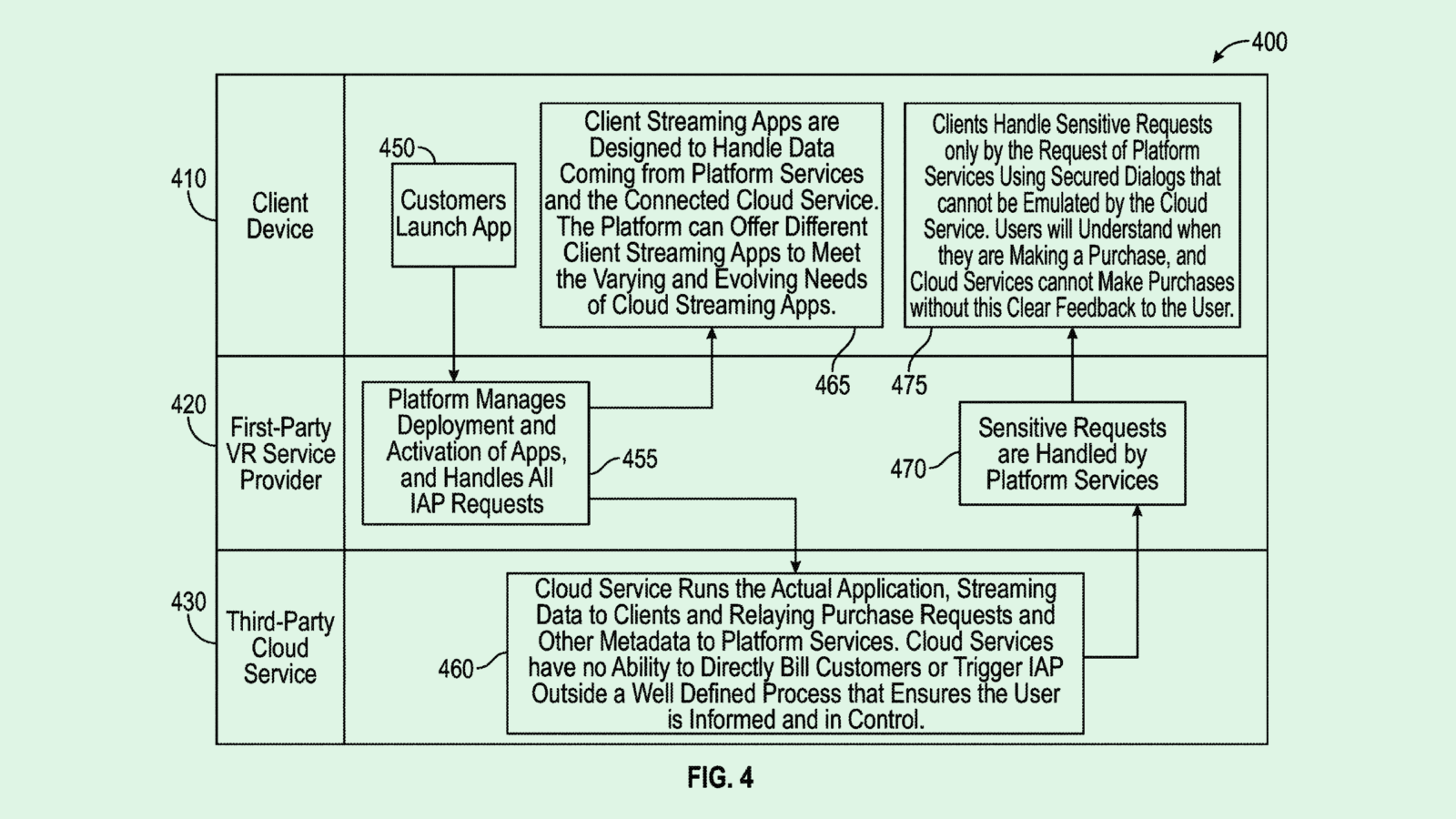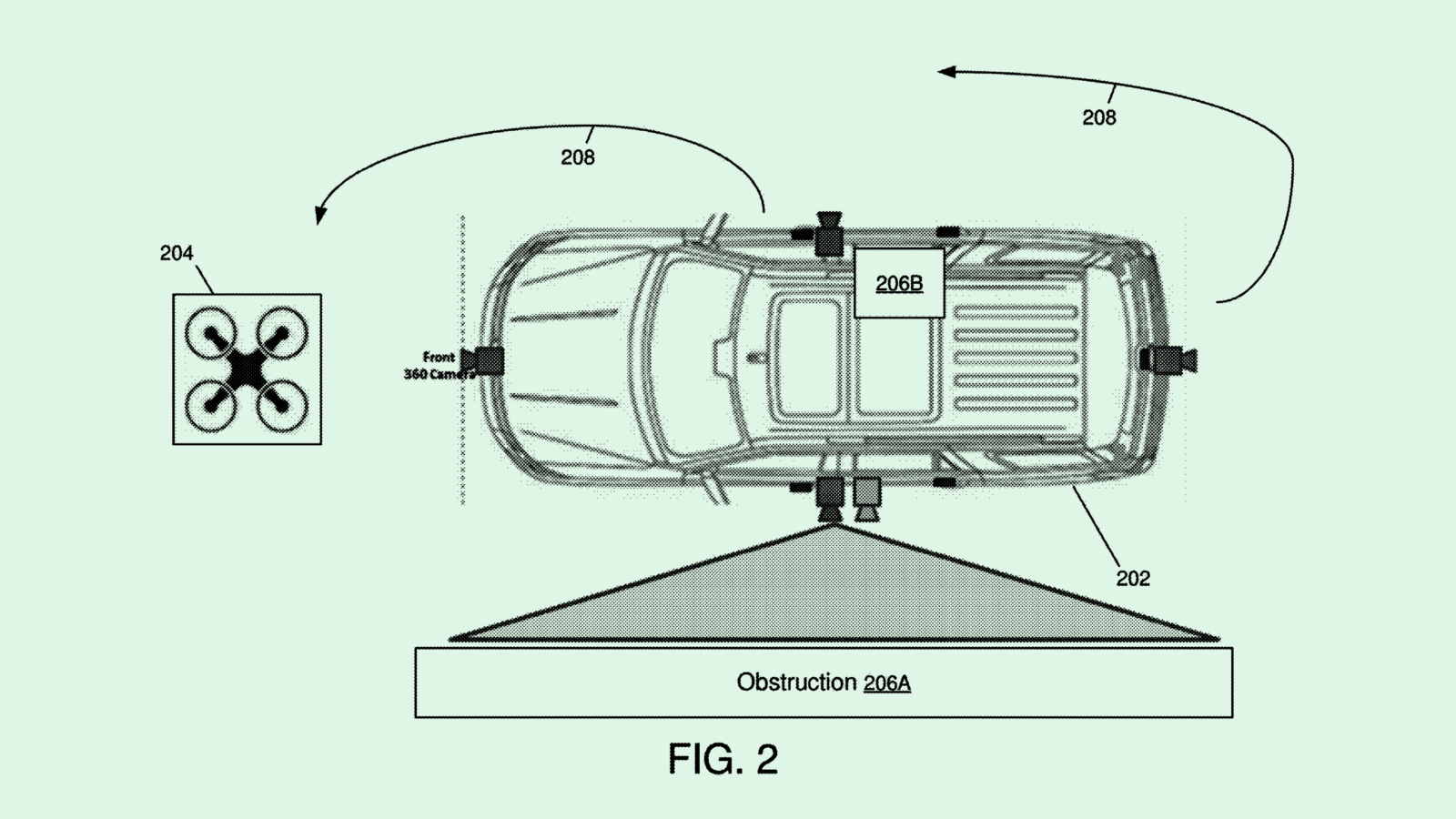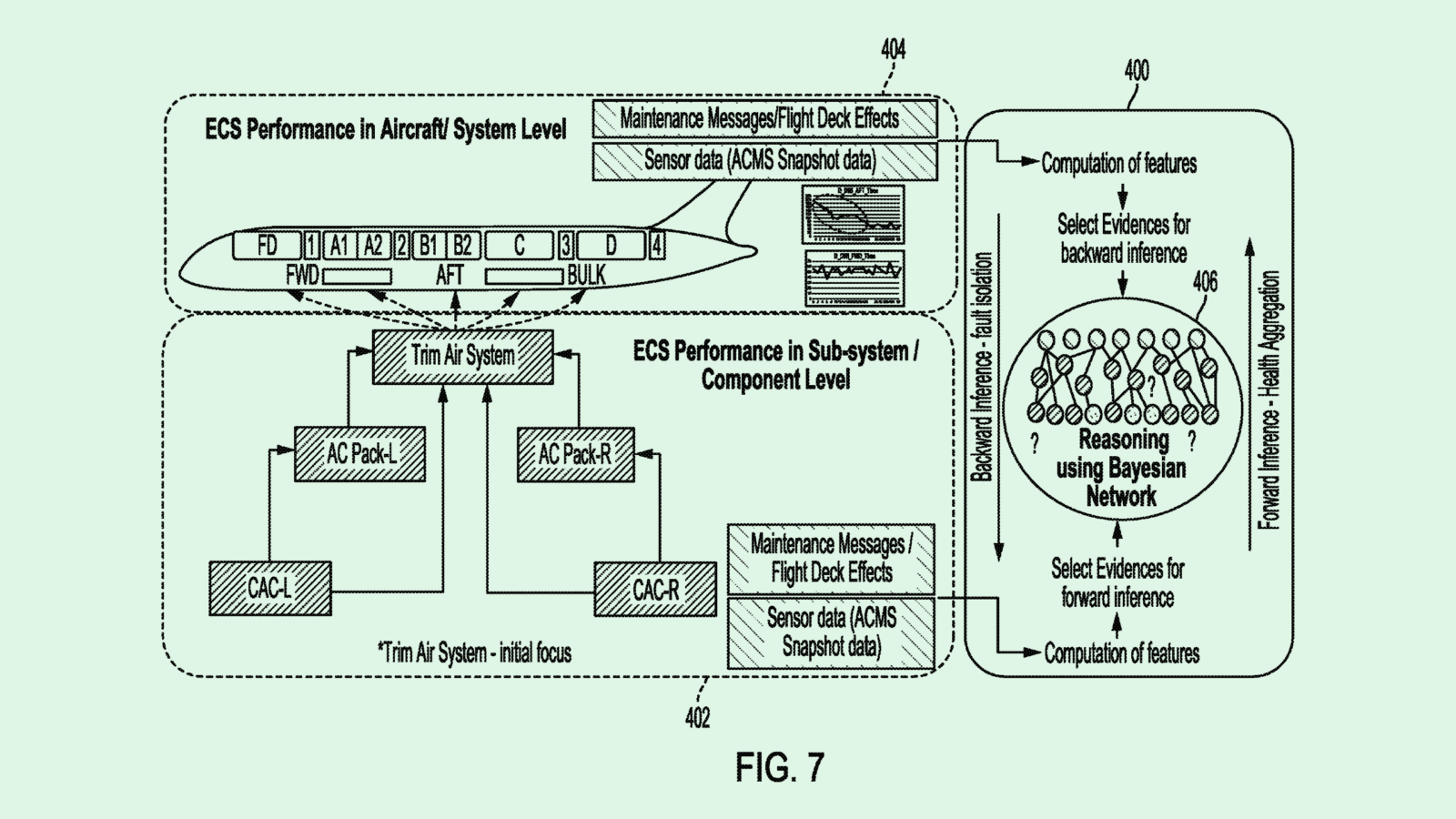Happy Monday and welcome to Patent Drop!
Today, Meta’s recent patent for a cloud gaming virtual reality ecosystem could open the door for cheaper, lighter headsets. Plus: Ford may be stacking autonomous vehicles, and Boeing wants to diagnose its airplanes’ problems.
Before we jump into today’s patents, a word from our sponsor, Brex. Any successful startup founder knows that runway is everything. Stretching each dollar is crucial, which is why 1 in 3 US startups use Brex. With Brex you get the best of checking, treasury, and FDIC protection in one account — learn more about Brex’s banking solutions.
Let’s peer behind the curtain.
Meta’s Cloud Nine
When it comes to the metaverse, Meta may have its head in the clouds.
The company filed a patent application for a “cloud virtual reality ecosystem.” Meta’s patent describes a powerful cloud gaming and application service that can immensely lighten the load on headsets by sending the computing tasks to third-party providers.
“Typically, VR computer code is rendered locally on a VR headset,” Meta said in the filing. “However, this approach requires locally installed powerful graphical hardware and computing resources.”
The tech itself is relatively simple: When a user wants to access a computing-intense application via their headset, a request is sent to a third-party cloud service consisting of several hosts. From those that are available, one is selected based on resource availability. Finally, a connection request is sent and, once approved by the user, application streaming is established.
In order to protect user data that may be collected in operating cloud-based applications, this ecosystem can be configured so actions related to sensitive and personal data are performed entirely on the headset (so long as that information is not required for rendering). For example, an in-app purchase via headset would be performed locally, with the “results of the transaction” sent to the cloud server.
However, personal data that is needed for rendering, such as face and eye tracking information, could require “explicit firewall permissions and may be auditable.” Meta noted that this “may be safer than having headsets process it locally because the server instances may be firewalled and monitored.”

Meta’s patent, though somewhat broadly focused, lays out a cloud gaming ecosystem that could take a ton of computational work off of the headsets themselves, said DJ Smith, co-founder and chief creative officer at The Glimpse Group.
Lighter-weight headsets have long been a part of the company’s product road map. Smart glasses, in particular, are a large part of this plan; Meta purchased a stake in Ray-Ban maker EssilorLuxottica as they partner on this tech. And a recent patent detailed lightweight headgear capable of VR and AR with a battery life between eight to 12 hours, compared to the Quest Pro’s two.
Shedding bulky processors in favor of cloud computing and slimming down the form factor could knock down barriers of adoption by making the experience frictionless. That stands to be lucrative both for Meta and whichever third-party cloud providers they partner with, said Trevor Morgan, senior vice president of operations at OpenDrives.
“This is a way to work with your major cloud providers in a consumer space,” said Morgan. “On the cloud provider side, this is opening up a really interesting new market.”
But this market might take a while to realize, said Smith. While cloud gaming platforms through Microsoft’s Xbox and Nvidia are already available to consumers, artificial reality cloud streaming isn’t quite there yet.
“We’re a long way from having devices that don’t have the processing built on board,” Smith said. “It’s also really going to be dependent on the [data center] infrastructure and the costs that are attached to it.”
The other potential hitch is privacy, said Morgan. Artificial reality headsets are constantly growing more capable of collecting a lot of personal data. While the patent attempts to reckon with the privacy issues this tech could cause, at the end of the day, it will still lead to more data in more places, he said, which creates a risk in and of itself.
“Imagine this thing gets compromised, and you’ve got millions of consumers whose personal and financial information gets compromised,” said Morgan. “That’s one quick way to kill your whole ecosystem.”
Extend Your Runway, Scale Your Business
A long runway is crucial for two types of people: pilots and startup founders.
Fortunately, airports tend to have well-maintained runways, but it’s a different story for founders. Why do most banks chip away at their funding with fees, minimums, and delays? Founders deserve better — that’s why Brex built a banking solution that helps startups take every dollar further.
With Brex, you get the best of checking, treasury, and FDIC protection in one account:
- Send and receive money fast worldwide.
- Earn industry-leading yield from your first dollar — while being able to access your funds anytime.
- Protect your cash with up to $6M in FDIC coverage through program banks.
Ready to join the 1 in 3 US startups using Brex and take every dollar further?
Ford’s Autonomous Russian Doll
Ford vehicles may someday come with a new kind of autonomy.
The company is seeking to patent “techniques for launching and landing a drone from the interior of a vehicle.” As the title suggests, Ford’s patent details ways to deploy an autonomous drone from an autonomous vehicle.
“Due to the sensors they carry, maneuverability, range, versatility, and much more, drones are becoming more and more commonly integrated with existing vehicle systems for off-road activities, people monitoring, and much more,” Ford said in the filing.
Ford noted that techniques for “drone-vehicle integration” typically involve exterior landing and deployment, and its tech offers a way to store and deploy the drone from the inside. In this scenario, the vehicle is equipped with an “interior sensor suite” and several potential exit points for an internally-docked drone’s departure.
The system uses AI and machine learning algorithms for object classification, identifying where occupants and objects are within the car and tracking their movement. Then, when the drone is deployed, its exit path is calculated to avoid obstacles.
While the drone is deployed, it can be used as a scout, searching for obstructions, crashes, or traffic slowdowns. The vehicle and drone remain in communication “so that the vehicle’s performance under the autonomous driving mode is enhanced.” The vehicle may control the “acceleration, speed, position, route, etc. of the drone relative to the vehicle,” and could link back to the vehicle to provide raw video feed of its surroundings.

Like the rest of the automotive industry, Ford has been hard at work on staking its claim in autonomous vehicles. The company previously sought to patent automated maintenance services for a fleet of self-driving vehicles. CEO Jim Farley also told Bloomberg TV last month that the company managed Level 3 autonomous driving, or partial autonomy, in testing.
This also isn’t the first time we’ve seen Ford take an interest in drones. The company has had patents granted for drone docking on the exterior of vehicles, which would activate in the event of an emergency. A Ford subsidiary also is using the rehabilitated Detroit’s Michigan Central Station to test drone deliveries.
Patents like this serve as a reminder that autonomous vehicles look like more than just cars themselves, especially as companies like Google, eBay, Amazon, and more research drones for their own use cases, whether it be last-mile delivery, emergency services, or maintenance.
How drones may be put to use by Ford, however, is up in the air. After the shutdown of Argo AI, a Ford-backed self-driving startup, in 2022, the automaker established Latitude AI with more than 500 of the startup’s former employees in mid-2023. This venture, Ford noted at the time, would focus on bringing self-driving technology to personally-owned vehicles.
However, if these turducken-esque autonomous vehicles have any ambition of hitting the open road, the company could face red tape on two fronts: the National Highway Traffic Safety Administration, which has already been busy trying to rein in autonomous vehicle firms for safety issues — Ford included – and the Federal Aviation Administration.
Boeing Finds a Fault
Boeing wants to figure out when molehills could become mountains.
The aerospace manufacturer filed a patent application for methods of “fault diagnosis” for complex systems within an aircraft. This tech aims to help minimize mishaps in unscheduled maintenance, particularly aiming to speed up troubleshooting.
Boeing noted that an “improved fault diagnosis system is especially important for unscheduled maintenance such that the troubleshooting process can be expedited in order to reduce the number of flights that have to be delayed or cancelled as a result of maintenance delays.”
The tech itself is somewhat simple: Boeing’s system continuously monitors operational sensor data that’s indicative of system performance and behavior to determine if certain systems are operating “outside normal ranges or thresholds.”
When a deviation is detected, the system determines if a particular mechanism is in a “degraded state.” The degraded conditions of that mechanism, as a “normal state” of operation tracked via machine learning, are fed to a diagnostic model trained to isolate the problem.
Boeing noted that this system could save time and resources needed to track down and solve complex issues in short periods of time, as well as “increase system reliability, safety, maintainability, availability, and affordability.”

Boeing has filed a number of patents that aim to automate maintenance and track anomalies. But the company’s safety practices have been subject to intense scrutiny since the start of this year after a string of incidents and near-disasters have caught the attention of regulators, including a door plug coming loose and engine fires during flights.
After a six-week audit of the company’s manufacturing processes, the Federal Aviation Administration alleged in March that Boeing had 97 instances of noncompliance, according to The New York Times. In May, the agency and the company met to lay out its safety turnaround plan, which included a “significant increase” of safety inspectors and 300 hours’ worth of new training materials.
While patents like these could be particularly helpful at catching breakdowns quickly amid Boeing’s safety woes, they also highlight the growing presence of AI and machine learning in manufacturing and inspection, whether it comes in the form of robotic co-workers, safety monitoring, or surveillance.
And though AI has the potential to make troubleshooting issues a much more streamlined process, models still often face accuracy issues, leading to the false positives and false negatives the tech seeks to negate. In the case of a commercial airline manufacturer, the consequences of these mistakes can be major.
Extra Drops
- Intel wants to know that you’re paying attention. The company wants to patent a system for “game focus estimation in team sports” for immersive video.
- Mastercard wants to make sure everyone can see what they’re buying. The credit card provider is seeking to patent a system for “accommodating color vision deficiency in financial transaction messages.”
- Oracle wants to know where your skills may be lacking. The company filed a patent application for “profile matching and generating gap scores and upskilling recommendations.”
What Else is New?
- Nvidia is reportedly working on a version of its flagship AI chip for the China market that’s compatible with U.S. export rules, according to Reuters.
- Canadian AI startup Cohere is valued at $5.5 billion after its recent Series D funding round brought in $500 million, according to Bloomberg.
- Brex Knows That Runway is Crucial. So they built a banking solution that helps founders take every dollar further. Unlike traditional banking solutions, Brex has no minimums and gives you access to 20x the standard FDIC protection via program banks. And you can earn industry-leading yield from your first dollar — while being able to access your funds anytime. Get Brex, the business account used by 1 in 3 US startups – learn more.*
* Partner
Patent Drop is written by Nat Rubio-Licht. You can find them on Twitter @natrubio__.
Patent Drop is a publication of The Daily Upside. For any questions or comments, feel free to contact us at patentdrop@thedailyupside.com.

